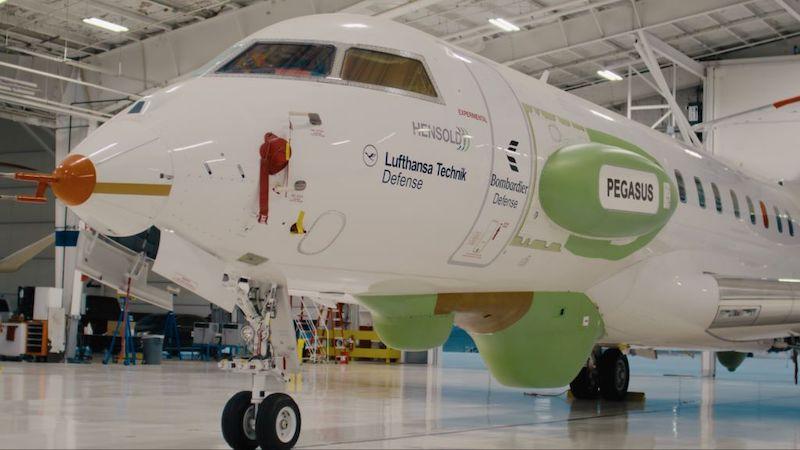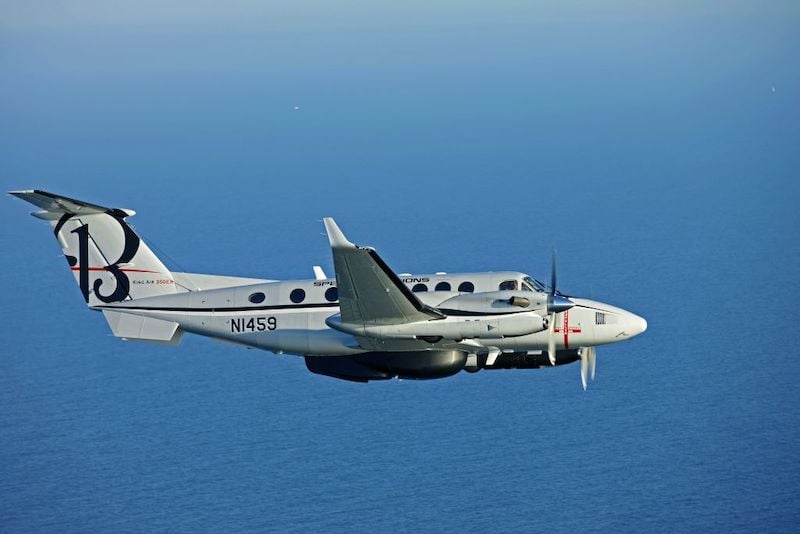
Lufthansa Technik Defense is installing the Pegasus signal intelligence system on a Bombardier Global 6000. Bombardier completed the foundational modification work for the project.
WICHITA—In June, Bombardier Defense, Bombardier’s special mission division, signed a deal with Germany’s Aero-Dienst for a new Challenger 650 converted for medevac use, with delivery in 2026.
Also in June, Bombardier rolled out the first modified Global 6000 for Germany’s Persistent German Airborne Surveillance System (Pegasus) program for use in airborne surveillance in a partnership with Lufthansa Technik. Ground testing is next.
In March, the U.S. Army Contracting Command awarded Textron Aviation a five-year contract for Cessna Grand Caravan EX turboprops for the Djiboutian Air Force. The contract follows delivery of three King Air 360ERs, including two for the Peruvian Naval Aviation and one for the Ecuadorian Naval Aviation forces.
The deals are some of the latest contracts awarded to business aircraft manufacturers in a growing segment of the business aviation industry: special mission aircraft. Using business aviation as their platform, it is a market dominated by Bombardier, Textron Aviation, Dassault, Gulfstream and others.
Gulfstream, for example, plans to showcase its special mission business during the Farnborough International Airshow in late July. The company notes that over the years, it has delivered more than 200 aircraft to organizations in more than 40 countries that have been customized for a “range of specialized duties.”
Special mission aircraft take part in roles beyond traditional combat missions, such as intelligence, reconnaissance and surveillance (ISR), mapping and aerial survey, training, flight inspection, utility, transport, maritime and border patrol, humanitarian aid, search and rescue, head of state and medevac services, among others.
Textron Aviation’s division includes all government sales and any modified aircraft for special purposes, “and the missions are anything you can imagine,” says Bob Gibbs, Textron Aviation vice president of special mission global sales and strategy. “We can do just about anything with just about any of our products.”
Although the special mission segment in the business aircraft industry does not receive much visibility, the aircraft do important work, says Rolland Vincent, an aviation consultant at Rolland Vincent & Associates.
“It’s not a huge chunk of the market, but it’s very consistent and can be a profitable piece of work for the providers,” Vincent says.
It is also a niche of growing importance.
Long Game
“We have gone into a very dangerous world,” Vincent says, which has created a need for long-range business jets that can fly over or near enemy areas.
Aircraft manufacturers compete heavily for the business, and lead times are long.
“It’s a really nice segment, but it’s hard to win,” Vincent says. “You have to play the long game.”
Bombardier’s goal for its special mission segment based in Wichita is to reach $1 billion in revenue by the end of the decade.
Textron Aviation’s special mission division, also based in Wichita, has tripled in size during the eight years Gibbs has been in his position, he says. “Every year has grown, and there’s no reason that won’t happen again.”
The companies do not publicly release segment revenue or the percentage of total revenue. But the sector is “significant,” Gibbs says.
At Bombardier, “it’s a growing proportion of our deliveries and revenues,” says Steve Patrick, vice president of Bombardier Defense, also based in Wichita.
Bombardier estimates the total special mission market demand will be up to 350 aircraft over the next 10 years.
“That’s the market we’re pursuing,” Patrick says. The forecast does not include trainers, fighters or Boeing tankers, for example.
Gulfstream’s special mission program began in 1967 with the TC-4C Academe, a modified Gulfstream I for the U.S. Navy. Since then, Gulfstream has continued to adapt business jets for government and military special missions applications around the world.
“We see opportunities for growth across the Gulfstream product line,” says Scott Neal, Gulfstream senior vice president of worldwide sales. “Continued growth and interest in Gulfstream’s special missions capabilities is driven by the range, endurance and efficiency of Gulfstream aircraft and Gulfstream’s unique ability to manage aircraft modifications in-house with a dedicated team of engineers and professionals at our special missions facility.”
Today, a record number of deliveries and projects are underway in VIP transport, command and control, ISR and airborne early warning, Neal says.
Lufthansa Technik in Germany specializes in transforming airliners and business jets, such as Bombardier’s Globals, into special mission aircraft.
“I think every area is growing at the moment,” says Wieland Timm, Lufthansa Technik senior director of sales for VIP and special mission aircraft services. Signals intelligence—or sigint—is growing the most due to the current global situation, he says. There is also a need for larger aircraft.
“We are in a good position because we are used to [working on] bigger aircraft” and completing specialized interiors, including medevacs, Timm says. “We also will have additional aircraft types here, which we can’t disclose for the moment,” he adds.
He says the business is growing and “we are very optimistic for the 10 years with regard to this special area of aircraft.”
NATO is currently seeking a replacement of the E-3 Sentry aircraft, a Boeing 707 with an airborne early warning and control system (AWACS), he says.
“It’s a really old aircraft,” Timm says. One idea is to replace it with the E-7 Wedgetail, based on the 737. With the experience Lufthansa Technik has on the 737, the company could supply its MRO and modification expertise.
“It hasn’t been decided yet, but we are currently in negotiations and have already expressed our interest in that aircraft,” he says. On the MRO side of its business, the company will also support the P-8A Poseidon for the German Navy, an aircraft also based on the 737.
“All of these military projects are our new playing field, and I think we can provide a lot of expertise and knowledge on how to ensure technical reliability for these aircraft,” Timm says.
Textron Aviation’s special mission division has a dedicated sales team, program management, engineering, supply chain, contracts, marketing, finance and other functions apart from the rest of the company. It is a subset of everything the company does.
“As the OEM, if we can understand what the customer needs, we can bring together the right technology with the right platform to give the customer the ideal tool, because we have 20 different products we can work with,” all of which Textron can customize, Gibbs says. “If you need an ambulance and you tell me how big it needs to be in the sense of how many beds, tell me how far you need to go, what kind of runways you’re going to operate off of and what budget you have, we’ll bring you a couple of choices to meet your need.”
Global Scope
The special mission world is a global industry.
“If you look at the world situation … Ukraine is obviously driving a lot of activity in Europe, and the NATO members in Europe are investing significantly in equipment, in updates and recapitalization,” says Bombardier’s Patrick. “So, there’s opportunity there. There’s also the geopolitics between the U.S. and China. And the U.S. is certainly reinvesting and updating and expanding its capabilities. The U.S. always has and always will be the largest defense market in the world.”
Besides the U.S. and Europe, there is interest from the Middle East and Asia. Australia, for example, is becoming a large market for Bombardier special mission aircraft.
At Bombardier, ISR and airborne early warning aircraft are in top demand, Patrick says.
“There’s a lot of interest there,” Patrick says. Next is demand for VIP and head-of-state transport and beyond that, for medevac aircraft.
Learjet business jets have been popular for medevac use for many years, he notes. Increasingly, however, customers are beginning to select Bombardier Challenger jets for the missions, which can hold more stretchers and have a longer range, he says. Some customers are looking toward the larger Global business jets for medevac uses.
“If someone is injured in Tahiti on vacation, and they need specialist care in Los Angeles, you don’t do that with a Learjet,” Patrick says. “There’s a niche market out there for long-range medical evacuation.”
At the same time, there is a market for charter operators and owner/operators to use their Global aircraft part time for medical evacuations by taking out some seats and installing medical beds.
“That’s one of the options we offer,” Patrick says. “Six days a week, your aircraft can be in a traditional VIP configuration.” Then if an emergency arises, the seats can be replaced with medical beds and it can fly to a medevac mission.
Many of the modifications are performed at Bombardier’s Wichita site in the former Learjet production facilities, but customers can choose where they would like the work to occur.
“We’re allowing our customers to decide how much they want us to do,” Patrick says.
In some cases, it is important for customers outside North America to have local work content. To that end, Bombardier can perform the work at its service center in the appropriate country or with partners in the country, he says.
Technology in the industry has evolved. In the past, a customer may have needed a Boeing 737 to carry all the necessary equipment. But technological advancements mean smaller aircraft can be more effective because they can fly higher and faster.
One of the challenges is the pace of government procurement.
“There is a fairly well-established process that can take years to come to fruition,” Patrick says. “Our ability to serve the market really is determined by the customer’s pace. We can bring solutions forward really quickly. We just need to go at the same speed as our customer … This is part of the journey.”
In the meantime, Bombardier is increasing its brand awareness and has expanded its business development and engineering teams in the special mission area.
Over the years, Gulfstream’s aircraft have addressed the need for advanced medevac, airborne security, advanced early warning, maritime surveillance and patrol, special electronic missions, telemetry range support, airborne research, high-altitude atmospheric research, priority transport missions, command and control and executive airlift.
Gulfstream has a team of engineers and professionals dedicated to its special missions business.

Following the 2014 merger of Cessna Aircraft and Beechcraft, which formed Textron Aviation, the company adopted Beechcraft’s long-term focus on the special mission market, something Cessna had historically been less focused on. That has evolved.
“We went from 'sell an airplane and let them figure it out,'” to being able to deliver a fully developed special mission aircraft, Gibbs says.
Today, the division becomes involved early in overall product strategy from the beginning of a project with an eye to what it can bring to special mission customers.
At Textron Aviation, utility transport, air ambulance and surveillance, which includes maritime missions, are the fastest-growing segments, Gibbs says.
King Airs and Caravans have historically been the most popular aircraft for Textron Aviation special mission customers.
A growing market is in military transport with the new SkyCourier aircraft. Many militaries are still using the large C130 to move crates and people, which is often not the most effective way to do it, Gibbs says.
In the past year, Textron Aviation has been promoting its Citation Longitude for maritime patrol roles following work and delivery to customers in that segment. It has been delivered to customers for that role.
The air ambulance sector has grown the most since the pandemic as providers replace older fleets with new. Today, cargo production rates are at their highest, Gibbs notes.
“We’re running as fast as we can,” he says.






